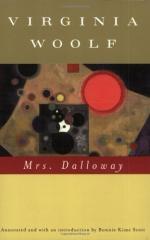|
This section contains 5,636 words (approx. 19 pages at 300 words per page) |

|
by Virginia Woolf
Mrs. Dalloway was Virginia Woolfs fourth novel, although many scholars consider it the first of her great works. Like the novel that preceded it, Jacobs Room (1922), Mrs. Dalloway deals obliquely with the events and social issues surrounding the First World War, focusing on the thoughts and emotions of a variety of characters who all experience these times from differing perspectives. Woolf, born in 1882 in London, was a member of the same upper middle class as most of the characters in Mrs. Dalloway, although her familys interests leaned toward intellectual pursuits instead of political ones. Her father, Sir Leslie Stephen, was a respected nineteenth-century scholar. As part of the collection of writers, artists, and intellectuals called the Bloomsbury Group, Woolf was close to people involved in politics; among these political activists were the noted economist Maynard Keynes (who was on the...
|
This section contains 5,636 words (approx. 19 pages at 300 words per page) |

|


